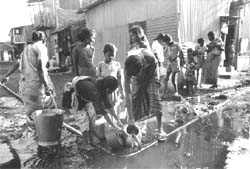Another plague in the offing
 The rash of leptospirosis cases in Mumbai during the current monsoon points towards the gradual breakdown of health services in burgeoning metropolises Another monsoon has crossed Mumbai coast and a second round of leptospirosis among other water-borne diseases has taken its toll. The epidemic has claimed around 40 lives so far. The figure last year touched 27. And this puts a big question mark over the efficiency of our health services in handling outbreak of diseases during the rainy season.
The rash of leptospirosis cases in Mumbai during the current monsoon points towards the gradual breakdown of health services in burgeoning metropolises Another monsoon has crossed Mumbai coast and a second round of leptospirosis among other water-borne diseases has taken its toll. The epidemic has claimed around 40 lives so far. The figure last year touched 27. And this puts a big question mark over the efficiency of our health services in handling outbreak of diseases during the rainy season.
In August last year and again in June this year, when leptospirosis deaths were reported from Mumbai, the civic authorities embarked on a feverish rat hunt armed with rat-traps and specialised rat-catchers. The health department formed crack squads comprising doctors and other health officials to carry out house to house checks in areas where cases of leptospirosis had been detected.
Leptospirosis, like cholera, is a disease of the poor and the marginalised. It is a febrile illness caused by infection due to Leptospira interrogans , that results from contact with the urine of infected animals, mainly rodents. The people at risk are those who live in shanties and around sewage contaminated waters. In Mumbai, since most slums are illegal, the Brihan Mumbai Municipal Corporation (bmc) provides them with limited services but no formal access to clean water, sanitation and health service.
A few patients with leptospirosis normally pass undetected during the initial stages of the epidemic. Once normal drugs, like anti-malarial, fail and the first few deaths occur, doctors panic and approach public health department who in turn approach specialist organisations. Each year, morgues are visited, samples from cadavers collected and serotypes matched and then stocked into repositories. Nothing actually happens with respect to surveillance, education, training and monitoring of the disease. For example, by the time official confirmation of the blood picture from the National Institute of Virology (niv), Pune, and the pathological reports from the state government's Haffkine Institute were released, the epidemic had blown over last year.
The first step to surveillance is to educate all medical practitioners about the disease prior to its outbreak. The disease is often confused with others like jaundice, malaria, or when terribly confounded by it, simply termed as a
